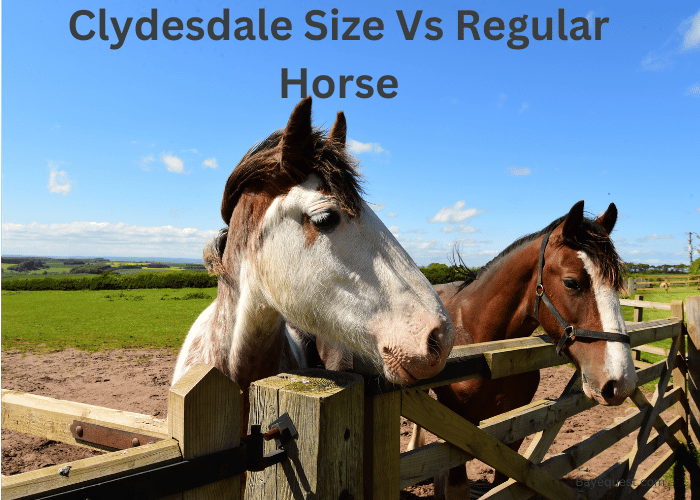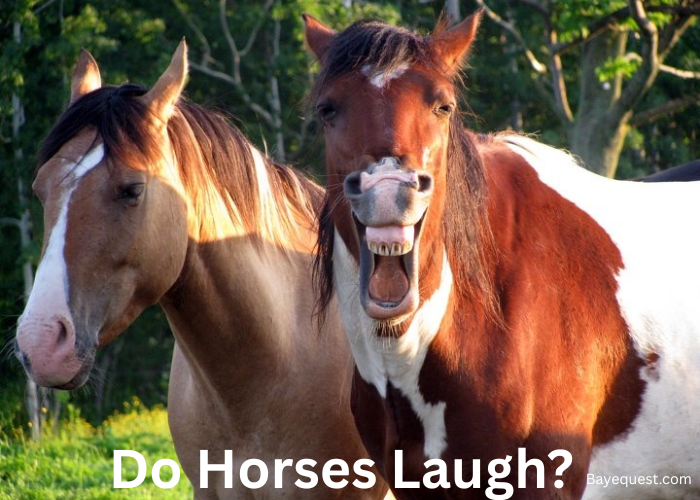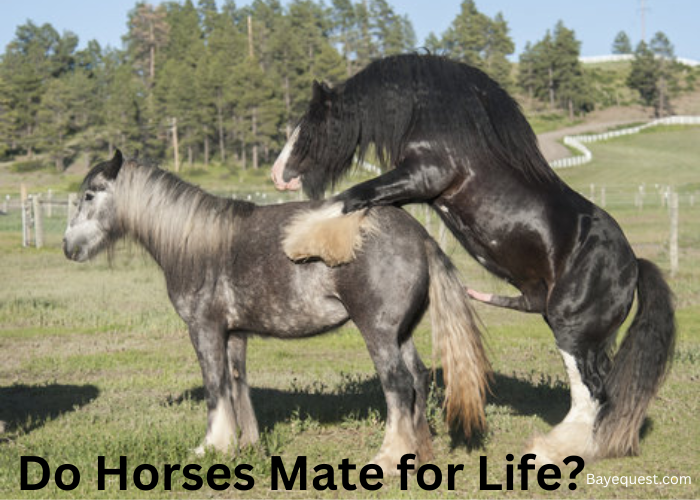Did you know a Clydesdale can weigh twice as much as a regular horse? With over a decade of experience in equine care, I’ve seen how their size affects their strength, health and maintenance.
If you’re unsure how these gentle giants compare to your average horse, you’re in the right place. In this article, we’ll break down the key differences and what they mean for you as a horse owner or enthusiast.
Stay tuned for insights that will reshape your understanding of these magnificent animals.
Clydesdale Size Vs Regular Horse: Key Takeaway
Clydesdales are much larger than regular horses. They stand between 16 to 18 hands tall (163-183 cm) and weigh 770 to over 1,000 kg. In comparison, regular horses typically stand around 15 hands tall (152 cm) and weigh between 380 to 500 kg.
About Clydesdale
Let’s talk about the Clydesdale, a true giant in the horse world, with roots stretching back to 18th century Scotland. This breed isn’t just big. It’s like the gentle giant of the equine family.
It’s a horse so sturdy and strong that it was the go-to for farmers and merchants back in the day. But there’s more to the Clydesdale than muscle and might.
These horses have impressive hooves, feathered with hair, and a gait that’s as smooth as it is powerful. They’ve got a presence that’s both commanding and calm, a rare blend that’s made them a favorite.
Their coat, ranging from bay to black, chestnut to roan, is often marked with striking white, catching the eye of anyone lucky enough to catch a glimpse.
But Clydesdales are more than their looks and labor. They carry a spirit of resilience, a legacy of the regions they come from. This spirit has seen them through changes in society, from agricultural stalwarts to beloved show horses and beyond.
So, when we talk about the Clydesdale, we’re not just talking about a horse. We’re talking about a symbol of strength, grace, and enduring partnership. It’s a breed that stands tall, not just in stature, but in the hearts of those who’ve worked alongside them.
About Regular Horse
When we talk about a “regular horse,” we’re dipping into a big, beautiful pool of breeds and types, each with its own flair and function.
Unlike the towering Clydesdales, these horses come in a variety of shapes and sizes. They fit any role you could imagine in the horse world.
These are the horses you might see grazing in a pasture, teaching kids to ride at a local stable, or taking a leisurely trail through the woods. They’re as versatile as they come, whether jumping over obstacles, dancing in dressage, or rounding up cattle.
And while they might not have the same imposing presence as a Clydesdale, they carry their own kind of beauty and grace.
Regular horses are anything but “regular.” Each has a personality, quirks that make them unique, and a unique way of moving.
They’re the everyday companions that horse lovers turn to for a ride, a challenge, or just a quiet moment away from the hustle and bustle of life.
So, while the term “regular” might suggest something ordinary, in the world of horses, it’s anything but. These horses are the heart and soul of the equine world, representing centuries of partnership between humans and horses.
They’re a testament to the diversity and adaptability of horses, each one with a special place in the world of equine enthusiasts.
Clydesdale and Regular Horse Comparison
Let’s compare our gentle giants, the Clydesdales, to the wide world of regular horses.
Regular horse and Clydesdales: Origins and habitats
The Clydesdale calls the lush, rolling hills of Scotland its ancestral home. Born out of the need for power and endurance in the fields and on the roads, these horses are like living legends from the misty lands of the north.
Their story is woven with the threads of Scottish history, culture, and the land itself.
On the other hand, regular horses hail from all corners of the globe. Each breed has its own origin story.
From the windswept steppes where the ancestors of our modern horses first ran wild to the farms, fields, and frontiers across the world. Their habitats are as diverse as their uses, adapting to life in both hot climates and cold, in mountains, plains, and everything in between.
Clydesdale Vs Regular Horse: Height
Now, let’s talk height. Clydesdales are the skyscrapers of the horse world. A typical Clydesdale stands tall at around 16 to 18 hands.
That’s up to six feet at the shoulder, folks. Walking next to a Clydesdale might make you feel a bit…well, short.
Regular horses, though, cover a broader spectrum. Your average riding horse stands about 14 to 16 hands high, making them more like the comfortable, two-story homes of the horse world. They are easier to mount and don’t need a ladder to brush their backs.
Regular Horse Vs Clydesdale: Weight
And what about weight? Clydesdales tip the scales with a heft that mirrors their height, ranging from a hefty 1,800 to over 2,000 pounds. They’re the heavyweight champions, built like the powerful, sturdy vehicles of the horse world.
Regular horses, meanwhile, are more in the middleweight category. Depending on the breed, they weigh anywhere from 900 to 1,200 pounds. It’s like comparing a rugged SUV to a versatile, all-purpose sedan. Each has its strengths, tailored to different needs and lifestyles.
Read more about Clydesdale’s weight on our other blog: “how much does a Clydesdale horse weigh?”
Clydesdale Horse vs Normal Horse: Life expectancy
Clydesdales, with their grand stature and gentle hearts, are with us for a good, long while. A Clydesdale’s lifespan is around 20 to 25 years.
It’s a testament to their resilience and the care they receive from those who adore them. Like well-loved barn guardians, they grow into their roles, from youthful vigor to the dignified grace of their elder years.
Regular horses, in this aspect, trot along a similar path. Their life expectancy hovers around 25 to 30 years. Though, it’s not uncommon for some to enjoy their golden hay well into their 30s with proper care and a pinch of luck.
These horses journey through life with us, sharing adventures, lessons, and many a sunset.
Regular horse and Clydesdale: Coat color
Now, onto the fashion show—coat colors.
The Clydesdale palette tends to stick to the classics. We’re talking bay, black, chestnut, and roan.
They are often dressed up with white markings splashed on their face, legs, and sometimes their belly. It’s their signature look, like wearing a tailored suit with custom details that catch the eye and tell a story.
On the other hand, regular horses strut a more extensive color spectrum. They’re the trendsetters of the equine world.
They sport coats in a dazzling array of colors from solid hues like black, bay, chestnut, and grey, to more exotic patterns like pinto, palomino, buckskin, and dapple.
It’s as if they’re each born with their own stylist, ready to showcase their unique beauty and personality.
In essence, both Clydesdales and regular horses share the stage of life with grace.
Clydesdales Vs Regular Horses: Temperament
Clydesdales? They’re the gentle giants of the horse world. Imagine the most easygoing, friendly giant you can, and you’ve got a good picture of a Clydesdale.
Their calm, good-natured demeanor makes them a favorite for families, parades, and anyone looking for a horse that’s as chill as a cool breeze on a warm day. Their laid-back attitude, combined with a willingness to work, endears them to folks far and wide.
Regular horses have a range of personalities as wide as the sky. From the spirited thoroughbred, itching for a sprint, to the patient and plodding draft horse, each breed brings its own flavor to the barn.
But if there’s one thread that connects them, it’s their keen sense of partnership with humans. Whether they’re bred for work, sport, or companionship, they’ve got an innate ability to connect, each in their own unique way.
Regular Horses Vs Clydesdales: Price
Dipping into the world of horse economics, Clydesdales can be, well, a bit of an investment. Purchasing one of these majestic beasts can set you back anywhere from a few thousand dollars to the price of a luxury car.
They’re not just horses. They’re living, breathing pieces of history and heart.
As for regular horses, the price tag swings wide, influenced by breed, pedigree, training, and purpose. You might find a trusty trail companion for a more modest sum, or you might invest in a future champion jumper for the cost of a small house.
The spectrum is broad, reflecting these animals’ diverse roles in our lives, from leisure and sport to work and beyond.
Related read: How much is a Clydesdale?
Clydesdales Vs Regular Horses: Roles
Clydesdales have been the movers and shakers, quite literally, of the agricultural and transport worlds. Today, they still work, but you’re more likely to see them in parades, commercials, or as ambassadors of their breed.
Regular horses? Their roles are as varied as their breeds. From the racehorse thundering down the track, the ranch horse managing a herd of cattle, to the family horse teaching the next generation to ride. They compete, they work, they are companions, and in every role, they touch our hearts.
Related read: Clydesdale Vs Shire.
Which one is Better? Clydesdale or Regular Horse?
Choosing between a Clydesdale and a regular horse is like asking whether you’d prefer a warm, hearty stew on a cold day or a refreshing salad on a sunny afternoon.
Each has its place, its moment of perfection, and its unique appeal. It’s not about which is better; it’s about what fits into the story of your life and your needs at this time.
If you’re drawn to the majesty and gentle nature of the Clydesdale, and you have the space and resources they require, then a Clydesdale might just be the companion of your dreams. They’re like living legends, bringing a sense of grandeur and history to every day.
If you’re looking for versatility, a horse that can switch from a leisurely trail ride one day to a competition the next, then a regular horse from one of the many breeds designed for those purposes might suit you better.
They offer a wide range of personalities, abilities, and connections that can fit almost any equine aspiration.
In essence, the question isn’t about better. It’s about a match. It’s about the connection between horse and human and how that fits into your life.
Whether it’s a Clydesdale or a regular horse, each brings its own kind of joy, challenge, and companionship. So, listen to your heart, consider your life, and choose the path that will bring you and your equine companion the greatest fulfilment.
Read also: Draft Horse Vs Clydesdale.
FAQs
Can you ride a Clydesdale?
Yes, you can ride a Clydesdale horse. Despite their grand size, Clydesdales are gentle and sturdy, making them suitable for riders. They might not be the first choice for competitive racing or jumping, but for leisurely rides, parades, or therapeutic riding, they’re wonderfully patient and accommodating companions.
Is there a bigger horse than Clydesdale?
Yes, there are breeds that can rival or even exceed the size of Clydesdales. The Shire horse, in particular, is often mentioned as being slightly larger. Shires and Clydesdales share a lot in terms of their draft horse qualities. However, Shires edge them out in terms of height and weight, making them one of the largest horse breeds in the world.
Are the Budweiser horses Clydesdales?
Yes, the famous Budweiser horses are indeed Clydesdales. These iconic horses have been associated with Budweiser since 1933. They are known for their appearances in parades, commercials, and other promotional materials. They’re a symbol of the brand, celebrated for their impressive size, striking appearance, and gentle temperament.
Conclusion
In the dance of hooves across the land, Clydesdales and regular horses each play their own tune. Big or small, each horse fills the world with its own kind of magic.
The towering Clydesdale, with its gentle heart, stands like a beacon of strength and serenity. Regular horses, with their vast array of colors and spirits, bring versatility and connection.
It’s not about size, but about the bond we share with these noble creatures. So, whether you’re drawn to the grandeur of Clydesdales or the diverse charm of regular horses, remember: each one can carry your dreams on their strong backs.








